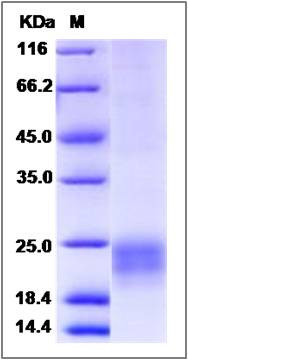Rhesus NKG2D / KLRK1 Protein (aa 78-216, His Tag)
KLRK1, NKG2D
- 100ug (NPP2903) Please inquiry
| Catalog Number | P90164-C07B |
|---|---|
| Organism Species | Rhesus |
| Host | Baculovirus-Insect Cells |
| Synonyms | KLRK1, NKG2D |
| Molecular Weight | The recombinant rhesus NKG2D consists of 155 amino acids and has a calculated molecular mass of 18.3 kDa. |
| predicted N | His |
| SDS-PAGE |  |
| Purity | > 95 % as determined by SDS-PAGE |
| Protein Construction | A DNA sequence encoding the rhesus NKG2D (NP_001028061.1) (Phe78-Val216) was expressed with a polyhistide tag at the N-terminus. |
| Bio-activity | 1. Immobilized Rhesus His-NKG2D (78-216) at 10 μg/ml (100 μl/well) can bind human ULBP1-Fch (P10679-H03H), The EC50 of human ULBP1-Fch (P10679-H03H) is 0.12-0.28 μg/ml. 2. Immobilized Rhesus His-NKG2D (78-216) at 10 μg/ml (100 μl/well) can bind human MICB-Fch (P10759-H03H), The EC50 of human MICB-Fch (P10759-H03H) is 33.8-79 ng/ml. |
| Research Area | Cancer |Signal transduction |Signaling Pathway |G Protein Signaling |Small G Protein |Ras GTPase Family | |
| Formulation | Lyophilized from sterile 20mM Tris, 500mM NaCl, 10% glycerol, pH 8.0 1. Normally 5 % - 8 % trehalose and mannitol are added as protectants before lyophilization. Specific concentrations are included in the hardcopy of COA. |
| Background | NKG2D, also known as CD314, is an immune receptor which consists of two disulphide-linked type II transmembrane proteins with short intracellular proteins uncapable to transduce signals. In order to transduce signals, NKG2D needs adaptor proteins and it uses two adaptor proteins, DAP10 and DAP12. These two adaptor proteins associate as homodimers to NKG2D- therefore the entire receptor complex appears as a hexamer. NKG2D can send co-stimulatory signals to activate CD8 T cells. NKG2D also plays an important role in viral control. Cellular stress can induce ligands for NKG2D which results in the cell susceptible to NK cell-mediated lysis. |
| Reference |
